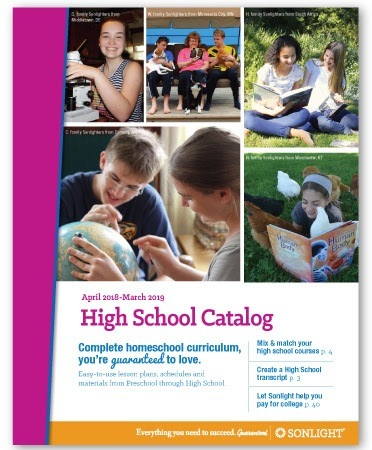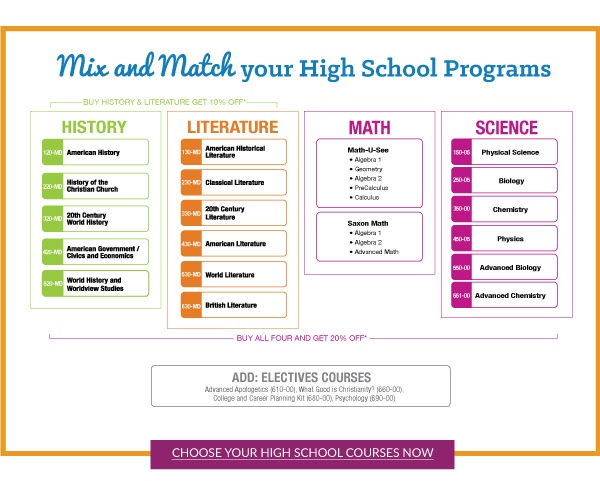I’ve often been asked which Sonlight levels we use for high school, how I determine which levels to do and which to skip. I’ve also been asked about some of the middle school levels (F, G, and H mainly) and whether or not they are high school-worthy. In other words, are they rigorous enough to assign high school credit on a transcript?

Before I get into my methods for choosing Sonlight for high school, I want to offer two examples that demonstrate just how rich a Sonlight education is at any level, and how a public high school course often pales in comparison.
Sonlight First Grade Versus My High School Education
I still remember the day when my oldest was just shy of 6 and using HBL B. A revelation flashed through my head, “I've never learned any of this in high school.”
It’s true. Despite attending a highly-rated school in a state with top education rankings, my history education in high school was lacking compared to Sonlight's program for ages 6-8! I was astounded that my child knew more about people and eras of history at age 6 than I did at 18.
In HBL B, we covered regions like Ancient Sumeria, Akkadia, and Nubia. We talked about people like Hammurabi, King Narmer, and Sargon the Great. We talked about historical events such as the Hyksos invasion of Egypt, the city-state building of Mohenjo Daro, and the rise and fall of Babylonia. And we weren’t even halfway through first grade! It was then that I had my first inkling of how much history schools fail to teach.
Sonlight American History Versus College American History
By the time my oldest had reached HBL D, American History Part I, I was back in college, taking an American history class with an extremely dry textbook. During the tests, I realized that I was pulling almost as many answers from what I learned via my daughter's Sonlight curriculum as I was from my college textbook. When I'd get confused about time periods, I’d relate the events to what was going on in the Sonlight Readers and Read-Alouds to find my chronological bearings.
Of course, Sonlight’s HBL D is not college level material. However, it provided an excellent scaffold for what I was learning in college. It was at that point that I realized I had been far less prepared for college than I could have been.
More Sonlight Programs Mean More Choices for High School
When my oldest was four years old, I planned her entire educational career starting with kindergarten on through homeschooling during high school. But by the time she was five, Sonlight came out with a new preschool program. Should I scrap my plan to fit in the new level? No, I decided to hold strong and keep moving forward with my original outline.
After a few other surprises and upsets to my plan, Sonlight transformed level 530—which had been a supplemental survey of British literature—into a full 500 level program. This change added an entire new level to choose from! And it wasn't part of my original plan.
Because I love Sonlight and want to enjoy all the programs, I revised my plan once again, moving things around to make room for this new addition. But, shortly afterward, Sonlight started releasing 600 level materials. It was at that point that I realized that we realistically couldn't fit in all the levels and that my high school plan didn’t have to include every program!
As recently as 2018, Sonlight has released yet another new program—HBL J History of Science. I have high hopes that someday soon there will be so many levels that a homeschool mom no longer feels pressured to do them all because she simply can’t. Instead, she picks and chooses the levels she feels will work best for each student, year by year.
Sonlight Middle School Versus Sonlight High School
Around the time our first student started high school, we had an extra student with us. To protect her privacy, I won’t say much about her. She hadn’t done all the Sonlight levels with our family, and so she wasn’t ready for the rigor of work in Sonlight's high school levels. Yet she had been in public school and was ready for high school according to her age.
So I needed to make a decision. Should I forge ahead into Sonlight's high school levels with her? Or should I back up and do a lower level to prepare her for the hundreds levels (high school) programs? If I did use a middle school Sonlight program with her, would it be enough to qualify for high school credit?
Who Defines a High School Course?
I started to study what made up a high school program, pouring over high school textbooks and syllabuses and interviewing high school teachers. What I learned was a surprise!
There is no standard level of work for any grade. Even with the new Common Core standards in place, each school district—sometimes each teacher—is responsible for choosing materials and determining what is required for completion. In addition, teachers have leeway on grading and assigning extra credit. I found a wide diversity in what was considered adequate for high school level courses. For example, one program for traditional students used ten books in their literature program, and another for the gifted program only covered four books.
How Does Sonlight Compare to Local High School Courses?
I performed a side-by-side comparison of Sonlight levels G, H, and 100 with what I uncovered from public and private high school courses (including two AP courses). I found that Sonlight came out ahead in almost every area:
- daily reading assignments
- number of books covered per year
- number of major topics touched on per year
- number and length of writing assignments
(Sonlight did not always exceed the AP level program requirements but in many ways was equal.) Based on my research, I determined that G and H are, in fact, high school-worthy programs.
To verify my conclusion, a couple of years later I spoke to the admissions officers at a local university that accepts students for dual enrollment. Both admissions officers took a look at the Sonlight catalog and the transcript I made and assured me that the university would accept Sonlight F, G, and H for high school level credit. They said the courses were more than adequate!
Of course, this is anecdotal evidence. I cannot speak for the entire country or for every college. But according to my experience, Sonlight middle school and high school curriculum provides an equal or superior education comparable with the high schools in my area (southern Texas). You can research this for yourself in your area by talking with college admissions counselors at colleges your child might be interested in.
How I Decide on Sonlight Courses for a 4-Year High School Plan
Since my research, I have long since given up extensive planning and worrying about levels. So rather than trying to squeeze in every single Sonlight program, I decide based on what the child needs and is interested in. There are so many options!
I have been counting Sonlight courses as the following high school credits:
- F Eastern Hemisphere—Geography, 1 credit
- G World History, Year 1 of 2—Geography, 1 credit
- H World History, Year 2 of 2—World History, 1 credit
- J History of Science—World History, 1 credit
- 100 American History—American History, 1 credit
- 200 Church History—Geography or World History, 1 credit
- 300 20th Century World History—World History, 1 credit
- 400 American Government—Government/Economics, ½ credit each
- 500 World History and Worldview Studies—World History or Geography, 1 credit
Each literature program is equivalent to 1 English credit on a high school transcript.
Know that you can trust the rigor of Sonlight's programs. They are enough—more than enough—for high school credit!
If you ever worry about designing the perfect high school plan, reach out to the Sonlight Advisors who can help you work through the process of weighing all your options.
Sonlight has homeschool consultants available to talk to you about the next step on your journey. Click here to schedule an appointment.











